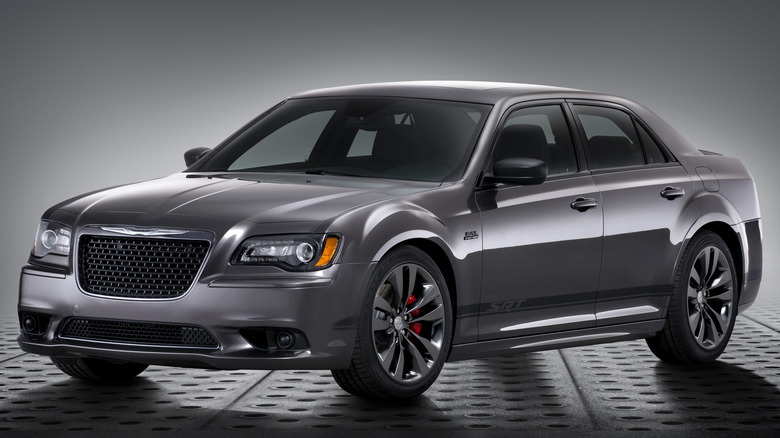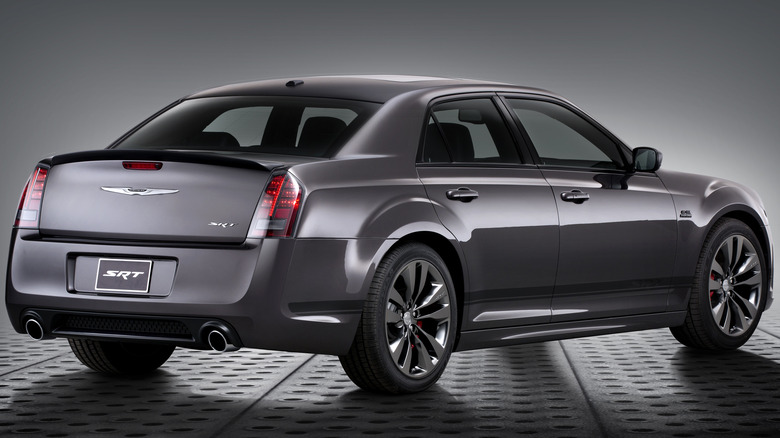Chrysler Built An Awesome Hemi-Powered Muscle Sedan, But Nobody Wanted It
The Chrysler 300 was always the more refined and stately option when it came to sedans from Stellantis — the now-parent company of both Dodge and Chrysler. While mechanically identical to the Dodge Challenger and Charger, the 300 had cleaner lines, more luxury options, and a few designer trims to boot. Still, the Chrysler 300 was essentially a Dodge Charger that took a shower, put on an Armani suit, and cut its hair.
While the Charger and Challenger twins had seemingly dozens of special editions and factory speed upgrades — namely the (in)famous supercharged 700-plus horsepower Hellcat and Demon versions — the Chrysler 300 was mostly left out of the performance conversation. The last model year for the 300 will be 2023, and Chrysler is sending it off with a bang — but for most of the 300's tenure here on planet Earth, the hottest 300 was equipped with a 5.7L V8 and that was about it. However, for a brief time in the early 2010s, seemingly out of nowhere, Chrysler unveiled the Chrysler 300 SRT, the fastest and meanest 300 ever produced.
A muscle car that cleans up well
In 2012, Chrysler followed a tried-and-true formula with the 300 SRT: Drop a huge 6.4-liter V8 in the car, and call it a day. In 2014, the model's final year, the SRT made 470 horsepower and 470 pound-feet of torque (per Stellantis). That propelled the car to 60 miles per hour within "the high four-second range" according to Stellantis, and the car was able to achieve a top speed of 175 miles per hour. In pop culture, a black Chrysler 300 SRT was prominently featured as Walter White's new car in the final few episodes of "Breaking Bad." Mirroring the character arc of Walter White, the 300 was transformed from an unassuming, if bland sedan, to an intimidating monster.
According to a press release from Stellantis, "The 2014 Chrysler 300 SRT sedan is targeted at customers that seek heart pounding, adrenaline-filled excitement, but don't want to sacrifice comfort and innovative features to get it." that demographic must not have existed in the quantity Stellantis expected, as its brother the Dodge Charger regularly outsold the 300 (via Stellantis). SRT versions of the Dodge Charger were essentially the same car as the SRT 300, with the same engine and specs, but was cheaper. The Chrysler had an MSRP of just a hair under $49,000, while the Dodge retailed for just over $46,000 (via Edmunds). Not to mention that options like leather seats on the supposedly more luxurious 300 were not standard equipment.
The Hellcat wins out
In the end, Stellantis ended up focusing on Dodge, as the company unleashed the Hellcat versions of the Charger and Challenger in 2015. The 6.4-liter V8 was no longer an option, and the Chrysler 300 would have to make do with a 5.7-liter engine until its final model year. It's unfortunate that the Chrysler 300 SRT never got the same Hellcat treatment during its run. With its big V8 and almost 500 horsepower, the Chrysler 300 SRT was civilized in the same way that an alligator wearing a top hat and a monocle would be.
The most recent iteration of the uber-300 was only around for three model years before doing a rolling burnout into the sunset. With Chrysler retiring the Charger, Challenger, and 300's platform and potentially moving towards EV performance cars, it's unlikely the world will see anything like the 300 SRT again — for good or ill.


